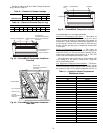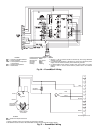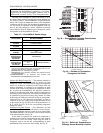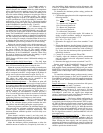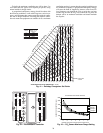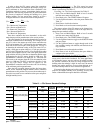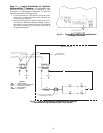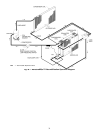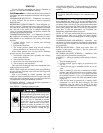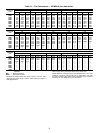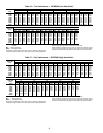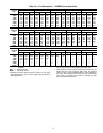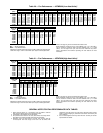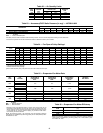
33
START-UP
Use the following information and Start-Up Checklist on
page CL-1 to check out unit PRIOR to start-up.
Unit Preparation — Check that unit has been installed in
accordance with these installation instructions and all applica-
ble codes.
COMPRESSOR MOUNTING — Compressors are internal-
ly spring mounted. Do not loosen or remove compressor
holddown bolts.
REFRIGERANT SERVICE PORTS — Each refrigerant sys-
tem has a total of 3 Schrader-type service gage ports. One port
is located on the suction line, one on the compressor discharge
line, and one on the liquid line. In addition Schrader-type
valves are located underneath the low-pressure switches. Be
sure that caps on the ports are tight.
COMPRESSOR ROTATION — It is important to be certain
the compressors are rotating in the proper direction. To deter-
mine whether or not compressors are rotating in the proper
direction:
1. Connect service gages to suction and discharge
pressure fittings.
2. Energize the compressor.
3. The suction pressure should drop and the discharge
pressure should rise, as is normal on any start-up.
If the suction pressure does not drop and the discharge
pressure does not rise to normal levels:
1. Note that the evaporator fan is probably also rotating
in the wrong direction.
2. Turn off power to the unit.
3. Reverse any two of the incoming power leads.
4. Turn on power to the compressor.
The suction and discharge pressure levels should now move
to their normal start-up levels.
NOTE: When compressors are rotating in the wrong direction,
the unit will have increased noise levels and will not provide
heating and cooling.
After a few minutes of reverse operation, the scroll
compressor internal overload protection will open, which will
activate the unit’s lockout and requires a manual reset. Reset is
accomplished by turning the thermostat on and off.
INTERNAL WIRING — Check all electrical connections in
unit control boxes; tighten as required.
GAS PIPING — Check gas piping for leaks.
CRANKCASE HEATER — Crankcase heater(s) is energized
as long as there is power to the unit and the compressor is not
operating.
EVAPORATOR FAN — Fan belt and variable pulleys are
factory-installed. See Tables 14-21 for fan performance data.
Be sure that fans rotate in the proper direction. See Table 22 for
air quantity limits. See Table 23 for static pressure information
for accessories and options. See Table 24 for fan rpm at various
motor pulley settings. See Tables 25 and 26 for evaporator fan
motor data. To alter fan performance, see Evaporator Fan
Performance Adjustment section on page 44.
NOTE: A 3
1
/
2
-in. bolt and threaded plate are included in the
installer’s packet. They can be added to the motor support
channel below the motor mounting plate to aid in raising the
fan motor.
CONDENSER-FANS AND MOTORS — Condenser fans
and motors are factory set. Refer to Condenser-Fan Adjustment
section on page 45 as required. Be sure that fans rotate in the
proper direction.
RETURN-AIR FILTERS — Check that correct filters are
installed in filter tracks (see Table 1). Do not operate unit
without return-air filters.
OUTDOOR-AIR INLET SCREENS — Outdoor-air inlet
screens must be in place before operating unit.
GAS HEAT — Verify gas pressures before turning on heat as
follows:
1. Turn off manual gas stop.
2. Connect pressure gage to supply gas pressure tap (see
Fig. 14).
3. Connect pressure gage to manifold pressure tap on gas
valve.
4. Turn on manual gas stop and set thermostat to HEAT
position. After the unit has run for several minutes, verify
that incoming pressure is 5.5 in. wg or greater, and that
the manifold pressure is 3.3 in. wg. If manifold pressure
must be adjusted, refer to Gas Valve Adjustment section
on page 46.
5. After unit has been in operation for 5 minutes, check
temperature rise across the heat exchangers. See unit
informative plate for correct rise limits of the heat
supplied. Air quantities may need to be adjusted to bring
the actual rise to within the allowable limits.
Disconnect gas piping from unit when leak
testing at pressure greater than
1
/
2
psig. Pres-
sures greater than
1
/
2
psig will cause gas
valve damage resulting in hazardous condi-
tion. If gas valve is subjected to pressure
greater than
1
/
2
psig, it must be replaced
before use. When pressure testing field-
supplied gas piping at pressures of
1
/
2
psig
or less, a unit connected to such piping must
be isolated by manually closing the gas
valve.
IMPORTANT: Unit power must be on for 24 hours prior
to start-up. Otherwise, damage to the compressor may
result.



